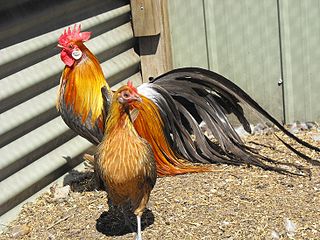
The Orpington is a British breed of chicken. It was bred in the late nineteenth century by William Cook of Orpington, at that time in Kent in south-east England. It was intended to be a dual-purpose breed, to be reared both for eggs and for meat, but soon became exclusively a show bird. The Australorp of Australia derives from it.

The Schnauzer or Mittelschnauzer is a German breed of dog in the Pinscher and Schnauzer group. It is characterised by an abundant bristly beard and whiskers, usually lighter than the coat. It is one of three Schnauzer breeds, the others being the Giant Schnauzer or Riesenschnauzer, and the Miniature Schnauzer or Zwergschnauzer. In Germany it is an endangered breed, and is listed in category III of the Rote Liste of the Gesellschaft zur Erhaltung alter und gefährdeter Haustierrassen.

The German Pinscher or Deutscher Pinscher is a German breed of terrier in the Pinscher and Schnauzer group. It shares common origins with the Schnauzer, of which it is essentially a short-haired equivalent. It is seen in two colours, either black-and-tan or self-coloured red, this varying from deer-red to a dark reddish brown.

The Emden or Embden is a German breed of domestic goose. It is named for the town of Emden in north-westernmost Germany.

The Phoenix is a German breed of long-tailed chicken. It derives from cross-breeding of imported long-tailed Japanese birds similar to the Onagadori with other breeds.

The Black Forest Horse is an endangered German breed of light draft horse from the Black Forest of southern Germany.

The Lakenvelder or Lakenfelder is a breed of domestic chicken from the Nordrhein-Westfalen area of Germany and neighbouring areas of the Netherlands. It was first recorded in 1727.

The Appenzeller Spitzhauben is a Swiss breed of crested chicken originating in the historical Appenzell region of Switzerland. It is one of two chicken breeds from that area, the other being the Appenzeller Barthuhn; the only other Swiss breed of chicken is the Schweizer.

The Westfälischer Totleger is a German breed of domestic chicken. It is more than 400 years old, and is a rare breed.

The Bergische Kräher is a German breed of domestic chicken from the Bergisches Land, in the state of North Rhine-Westphalia in western Germany. It is named for its unusually long crow, up to five times as long as that of other breeds, and belongs to the group of long-crowing chicken breeds, which are found from south-east Europe to the Far East.

The Friesian or Frisian, Dutch: Fries Hoen, is an ancient Dutch breed of chicken. It originates in Friesland, on the North Sea coast of the northern Netherlands.

The Gesellschaft zur Erhaltung alter und gefährdeter Haustierrassen or GEH is a German national association for the conservation of historic and endangered domestic animal breeds.

The Rotes Höhenvieh is a breed of red cattle from the Central Uplands of Germany. It was created in 1985 as a merger of the few remaining examples of a number of closely similar regional breeds of upland red cattle. Reconstruction of the breed was made possible by the discovery of a stock of semen in a sperm bank. The name means "red upland cattle".
The Rote Liste, full name Rote Liste der bedrohten Nutztierrassen im Bundesgebiet, is a red list of threatened breeds of domestic animal published annually by the Gesellschaft zur Erhaltung alter und gefährdeter Haustierrassen, the German national association for the conservation of historic and endangered domestic animal breeds.

The Bielefelder Kennhuhn or Bielefelder is a German breed of domestic chicken. It was developed in the area of Bielefeld in the 1970s by Gerd Roth, who cross-bred birds of Malines and Welsumer stock with American Barred Rocks to create the breed. Like other breeds with Barred Rock parentage, it is auto-sexing – chicks of different sexes can be distinguished by their colour. There is a bantam version, the Bielefelder Zwerg-Kennhuhn.

The Bergische Schlotterkamm is an old and endangered German breed of domestic chicken. It originates from the Bergisches Land, in the state of North Rhine-Westphalia in western Germany, and is one of three chicken breeds from that area, the others being the Bergische Kräher and the German creeper ("Krüper").

The Augsburger is an endangered German breed of domestic chicken. It originates from the area of the city of Augsburg, in the Swabian region of the state of Bavaria, in southern Germany. It was bred in the nineteenth century, and derives mostly from the French La Flèche breed. It is the only chicken breed of Bavarian origin.

The German Pekin, German: Deutsche Pekingente, is a European breed of domestic duck. It is commonly called simply Pekin or White Pekin. It is a different breed from the American Pekin, which is also commonly known by the same names. It was bred in Europe from birds originating in China and Japan and is distributed in many European countries.

The Krüper is a German breed of creeper chicken. It originates in the former Duchy of Berg, now the Bergisches Land in western Germany, and is one of three chicken breeds from that area, the others being the Bergische Kräher and the Bergische Schlotterkamm. It belongs to the group of original European creeper breeds. The breed has normal-sized and bantam varieties.

The Niederrheiner is a German breed of chicken. It is named for the Niederrhein or Lower Rhine region where it originated in the early twentieth century, and derives principally from the Dutch North Holland Blue meat chicken. It was recognized in Germany in 1943. In the twenty-first century it is an endangered breed.





















